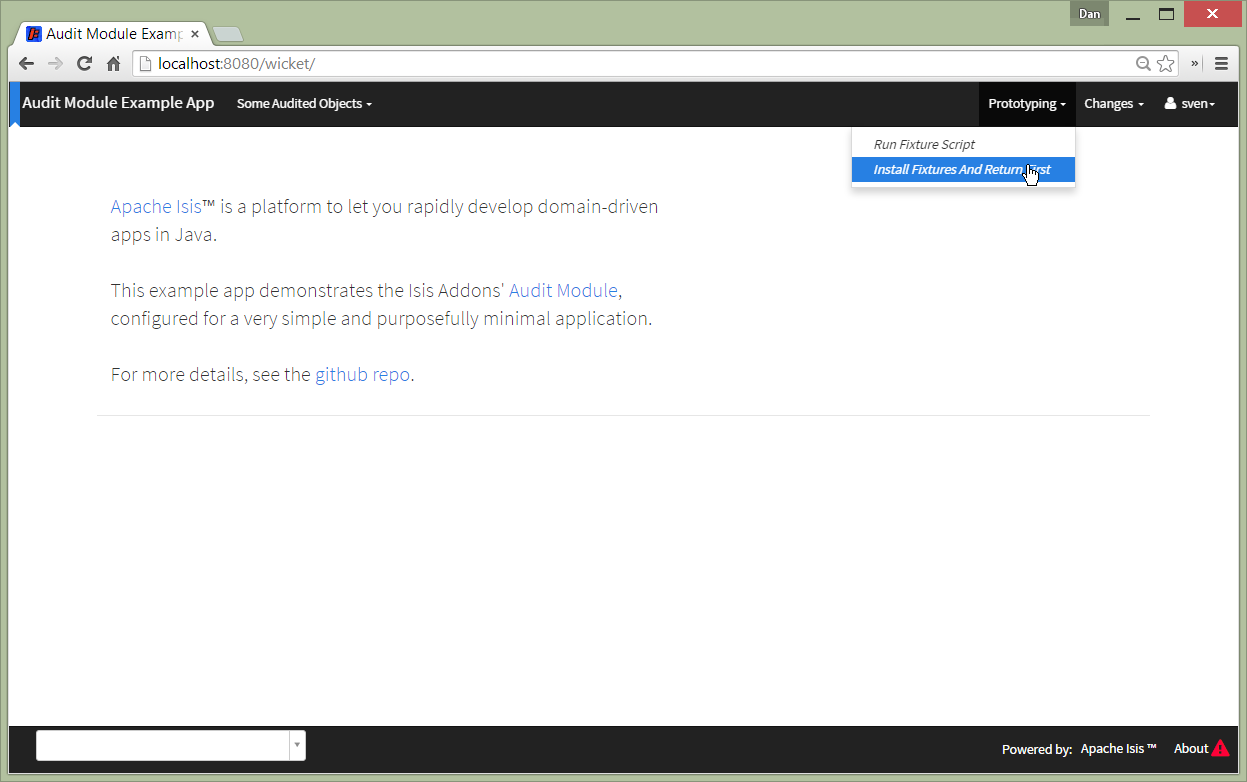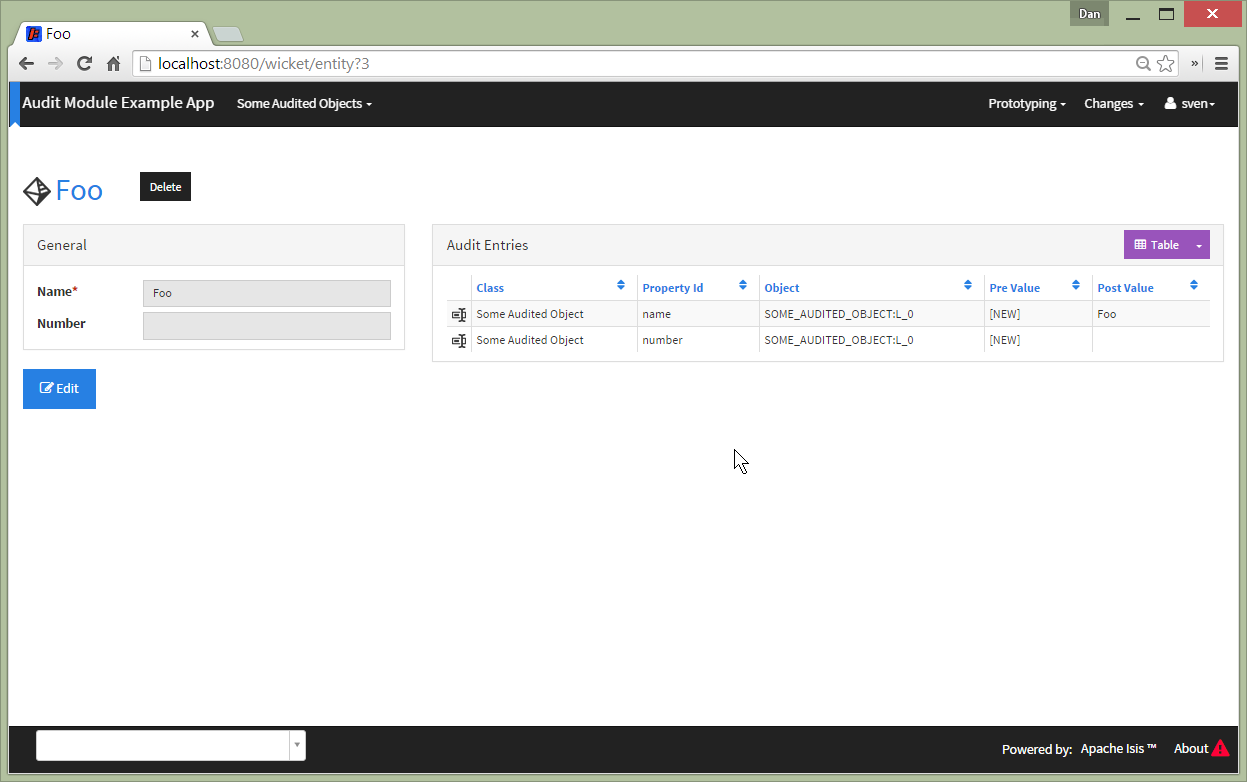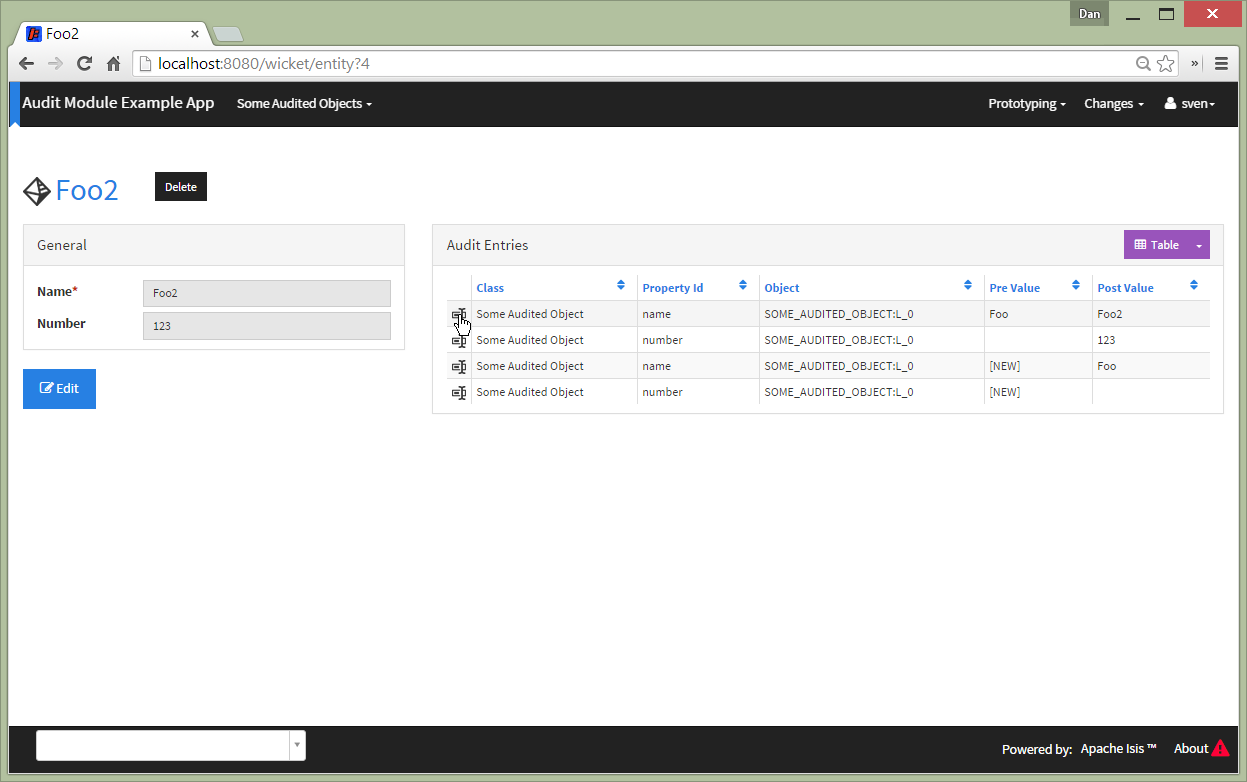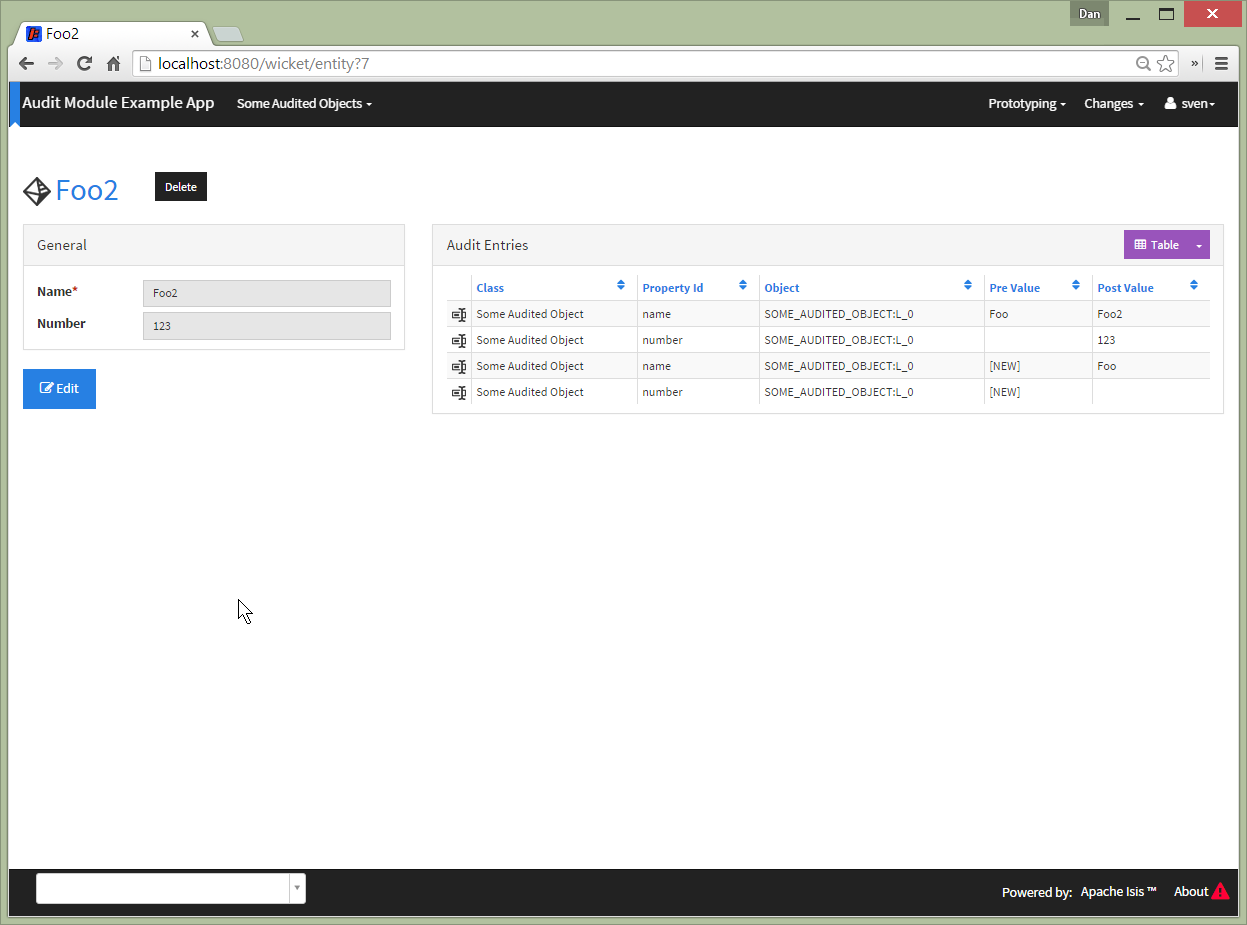This module, intended for use within Apache Isis, provides an implementation of Isis'
AuditerService SPI (introduced in 1.13.0, replacing the earlier AuditingService3 SPI).
The implementation persists audit entries using Isis' own (JDO) objectstore.
Typically this will be to a relational database; the module’s AuditEntry entity is mapped to the "isisaudit.AuditEntry" table.
The following screenshots show an example app’s usage of the module.
Because the example entity is annotated with @DomainObject(auditing = Auditing.ENABLED), the initial creation of
that object already results in some audit entries:
As the screenshot shows, the demo app lists the audit entries for the example entity (a polymorphic association
utilizing the BookmarkService).
Changing two properties on an object:
which results in two audit entries created, one for each property:
The prerequisite software is:
-
Java JDK 7
-
maven 3 (3.3.x is recommended).
To build the demo app:
git clone https://github.com/isisaddons/isis-module-audit.git
mvn clean installTo run the demo app:
cd webapp
mvn jetty:runThen log on using user: sven, password: pass
Apache Isis Core 1.6.0 included the org.apache.isis.module:isis-module-audit-jdo:1.6.0 Maven artifact.
This module is a direct copy of that code, with the following changes:
-
package names have been altered from
org.apache.isistoorg.isisaddons.module.audit -
the
persistent-unit(in the JDO manifest) has changed fromisis-module-audit-jdotoorg-isisaddons-module-audit-dom
Otherwise the functionality is identical.
Apache Isis 1.7.0 (and later) no longer ships the org.apache.isis.module:isis-module-audit-jdo module; use this addon module instead.
You can either use this module "out-of-the-box", or you can fork this repo and extend to your own requirements.
To use "out-of-the-box":
-
update your classpath by adding this dependency in your project’s
dommodule’spom.xml:<dependency> <groupId>org.isisaddons.module.audit</groupId> <artifactId>isis-module-audit-dom</artifactId> <version>1.14.0</version> </dependency>
-
if using
AppManifest, then update itsgetModules()method:@Override public List<Class<?>> getModules() { return Arrays.asList( ... org.isisaddons.module.audit.AuditModule.class, ); }
-
otherwise, update your
WEB-INF/isis.properties:isis.services-installer=configuration-and-annotation isis.services.ServicesInstallerFromAnnotation.packagePrefix=\ ...,\ org.isisaddons.module.audit.dom,\ ...
Notes:
-
Check for later releases by searching Maven Central Repo.
For audit entries to be created when an object is changed, some configuration is required. This can be either on a case-by-case basis, or globally
-
by default no object is treated as being audited unless it has explicitly annotated using
@Audited. This is the option used in the example app described above. -
alternatively, auditing can be globally enabled by adding a key to
isis.properties:isis.services.audit.objects=all
An individual entity can then be explicitly excluded from being audited using @Audited(disabled=true).
The AuditerService defines the following API:
@Programmatic
public void audit(
final UUID transactionId,
final int sequence,
final String targetClass,
final Bookmark target,
final String memberIdentifier,
final String propertyId,
final String preValue,
final String postValue,
final String user,
final java.sql.Timestamp timestamp);Isis will automatically call this method on the service implementation if configured. The method is called often, once for every individual property of a domain object that is changed.
The AuditerService API is implemented in this module by the org.isisaddons.module.audit.AuditerServiceUsingJdo class.
This implementation simply persists an audit entry (AuditEntry) each time it is called.
This results in a fine-grained audit trail.
The AuditEntry properties directly correspond to parameters of the AuditerService audit() API:
public class AuditEntry
...
private UUID transactionId;
private int sequence;
private String targetClass;
private String targetStr;
private String memberIdentifier;
private String propertyId;
private String preValue;
private String postValue;
private String user;
private Timestamp timestamp;
...
}where:
-
transactionIdis a unique identifier (a GUID) of the transaction in which this audit entry was persisted. -
timestampis the timestamp for the transaction -
targetClassholds the class of the audited object, egcom.mycompany.myapp.Customer -
targetStrstores a serialized form of theBookmark, in other words a provides a mechanism to look up the audited object, egCUS:1234to identify customer with id 1234. ("CUS" corresponds to the@ObjectTypeannotation/facet). -
memberIdentifieris the fully-qualified class and property Id, similar to the way that Javadoc words, egcom.mycompany.myapp.Customer#firstName -
propertyIdis the property identifier, egfirstName -
preValueholds a string representation of the property’s value prior to it being changed. If the object has been created then it holds the value "[NEW]". If the string is too long, it will be truncated with ellipses '…'. -
postValueholds a string representation of the property’s value after it was changed. If the object has been deleted then it holds the value "[DELETED]". If the string is too long, it will be truncated with ellipses '…'.
The combination of transactionId, targetStr and propertyId make up an alternative key to uniquely identify an
audit entry.
However, there is (deliberately) no uniqueness constraint to enforce this rule.
The AuditEntry entity is designed such that it can be rendered on an Isis user interface if required.
As well as the AuditingService service (that implements the AuditingService3 API), the module also provides two
further domain services:
-
The
AuditingServiceMenuprovides actions to search for `AuditEntry`s, underneath an 'Activity' menu on the secondary menu bar. -
AuditingServiceRepositoryprovides the ability to search for persisted (AuditEntry) audit entries. None of its actions are visible in the user interface (they are all@Programmatic) and so this service is automatically registered. -
HasTransactionId_auditEntriesmixin contribues theauditEntriescollection to theHasTransactionIdinterface. This will therefore display all audit entries that occurred in a given transaction, in other words whenever a command, a published event or another audit entry is displayed.
(As of 1.8.x and later) these services are automatically registered, meaning that any UI functionality they provide will appear in the user interface. If this is not required, then either use security permissions or write a vetoing subscriber on the event bus to hide this functionality, eg:
@DomainService(nature = NatureOfService.DOMAIN)
public class HideIsisAddonsAuditingFunctionality extends AbstractSubscriber {
@Programmatic @Subscribe
public void on(final AuditingModule.ActionDomainEvent<?> event) { event.hide(); }
}As well as defining the AuditingService3 API, Isis' applib also defines several other closely related services.
Implementations of these services are referenced by the Isis Add-ons website.
The CommandContext defines the Command class which provides request-scoped information about an action invocation.
Commands can be thought of as being the cause of an action; they are created "before the fact".
Some of the parameters passed to AuditingService3 - such as target, user, and timestamp - correspond exactly to the Command class.
The CommandService service is an optional service that acts as a Command factory and allows Command`s to be
persisted.
`CommandService’s API introduces the concept of a `transactionId; once again this is the same value as is passed to the AuditingService3.
The PublishingService is another optional service that allows an event to be published when either an object has
changed or an actions has been invoked.
There are some similarities between publishing to auditing; they both occur "after the fact".
However the publishing service’s primary use case is to enable inter-system co-ordination (in DDD terminology, between bounded contexts).
As such, publishing is much coarser-grained than auditing, and not every change need be published.
Publishing also uses the transactionId.
The CommandService and PublishingService are optional; as with the AuditingService3, Apache Isis will automatically use call each if the service implementation if discovered on the classpath.
If all these services are configured - such that commands, audit entries and published events are all persisted, then the transactionId that is common to all enables seamless navigation between each.
(This is implemented through contributed actions/properties/collections; AuditEntry implements the HasTransactionId interface in Isis' applib, and it is this interface that each module has services that contribute to).
In 1.6.0 through 1.9.x a call to DomainObjectContainer#flush() is required in order that any newly created objects are populated.
Note that Apache Isis automatically performs a flush prior to any repository call, so in many cases there may not be any need to call flush explicitly.
-
1.14.0- released against Isis 1.14.0 -
1.13.0- updated for Isis 1.13.0, implementing the newAuditerServiceSPI rather than the now deprecatedAuditingService3SPI. -
1.12.1- released against Isis 1.12.1, providing 'Metadata' fieldset, also using lombok and mixins internally -
1.12.0- released against Isis 1.12.0 -
1.11.0- released against Isis 1.11.0 -
1.10.0- released against Isis 1.10.0 -
1.9.0- released against Isis 1.9.0; changed mapped of entities to 'isisaudit' schema; updated to use AppManifest -
1.8.2- released against Isis 1.8.0; closes <a href="https://github.com/isisaddons/isis-module-audit/issues/1">#1</a> -
1.8.1- released against Isis 1.8.0 (fixed). -
1.8.0- released against Isis 1.8.0 (nb: this was a bad release, incorrectly referenced -SNAPSHOT version of Isis core). -
1.7.0- released against Isis 1.7.0 -
1.6.0- re-released as part of isisaddons, with classes under packageorg.isisaddons.module.audit
The format of the AuditEntry table has changed from 1.12.x to 1.13.x, incorporating a new sequence column
(which is also part of the primary key).
The following script updates the table (SQL Server syntax):
alter table isisaudit.AuditEntry
add "sequence" int
go
update isisaudit.AuditEntry
set "sequence" = 0
where "sequence" is null
go
alter table isisaudit.AuditEntry
alter column "sequence" not null
go
drop index AuditEntry_ak
on isisaudit.AuditEntry
go
create index AuditEntry_ak
on isisaudit.AuditEntry
(
transactionId ASC,
"sequence" ASC,
target ASC,
propertyId ASC
)
goCopyright 2014-2016 Dan Haywood
Licensed under the Apache License, Version 2.0 (the
"License"); you may not use this file except in compliance
with the License. You may obtain a copy of the License at
http://www.apache.org/licenses/LICENSE-2.0
Unless required by applicable law or agreed to in writing,
software distributed under the License is distributed on an
"AS IS" BASIS, WITHOUT WARRANTIES OR CONDITIONS OF ANY
KIND, either express or implied. See the License for the
specific language governing permissions and limitations
under the License.If you want to extend this module’s functionality, then we recommend that you fork this repo. The repo is structured as follows:
-
pom.xml- parent pom -
app- the app module used for bootstrapping, containing theAppManifest; depends ondomandfixture -
dom- the module implementation, depends on Isis applib -
fixture- fixtures, holding a sample domain objects and fixture scripts; depends ondom -
integtests- integration tests for the module; depends onapp -
webapp- demo webapp (see above screenshots); depends onapp
Only the dom project is released to Maven Central Repo. The versions of the other modules are purposely left at
0.0.1-SNAPSHOT because they are not intended to be released.
Only the dom module is deployed, and is done so using Sonatype’s OSS support (see user guide).
To deploy a snapshot, use:
pushd dom
mvn clean deploy
popdThe artifacts should be available in Sonatype’s Snapshot Repo.
If you have commit access to this project (or a fork of your own) then you can create interim releases using the interim-release.sh script.
The idea is that this will - in a new branch - update the dom/pom.xml with a timestamped version (eg 1.14.1.20161017-0738).
It then pushes the branch (and a tag) to the specified remote.
A CI server such as Jenkins can monitor the branches matching the wildcard origin/interim/* and create a build.
These artifacts can then be published to a snapshot repository.
For example:
sh interim-release.sh 1.14.1 originwhere
-
1.14.1is the base release -
originis the name of the remote to which you have permissions to write to.
The release.sh script automates the release process. It performs the following:
-
performs a sanity check (
mvn clean install -o) that everything builds ok -
bumps the
pom.xmlto a specified release version, and tag -
performs a double check (
mvn clean install -o) that everything still builds ok -
releases the code using
mvn clean deploy -
bumps the
pom.xmlto a specified release version
For example:
sh release.sh 1.14.1 \
1.15.0-SNAPSHOT \
dan@haywood-associates.co.uk \
"this is not really my passphrase"where
* $1 is the release version
* $2 is the snapshot version
* $3 is the email of the secret key (~/.gnupg/secring.gpg) to use for signing
* $4 is the corresponding passphrase for that secret key.
Other ways of specifying the key and passphrase are available, see the `pgp-maven-plugin’s documentation).
If the script completes successfully, then push changes:
git push origin master && git push origin 1.14.1If the script fails to complete, then identify the cause, perform a git reset --hard to start over and fix the issue before trying again.
Note that in the dom’s `pom.xml the nexus-staging-maven-plugin has the autoReleaseAfterClose setting set to true (to automatically stage, close and the release the repo).
You may want to set this to false if debugging an issue.
According to Sonatype’s guide, it takes about 10 minutes to sync, but up to 2 hours to update search.






